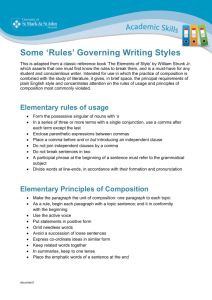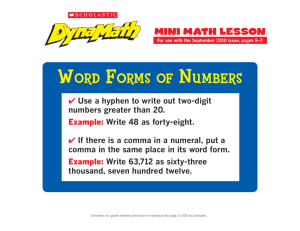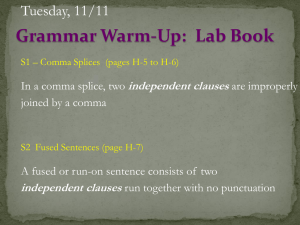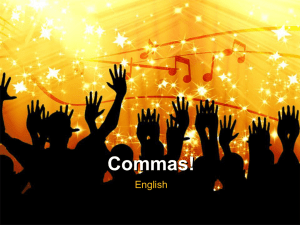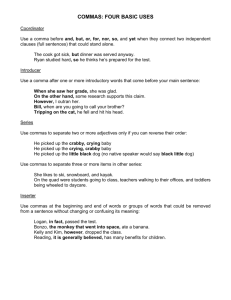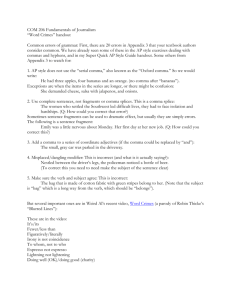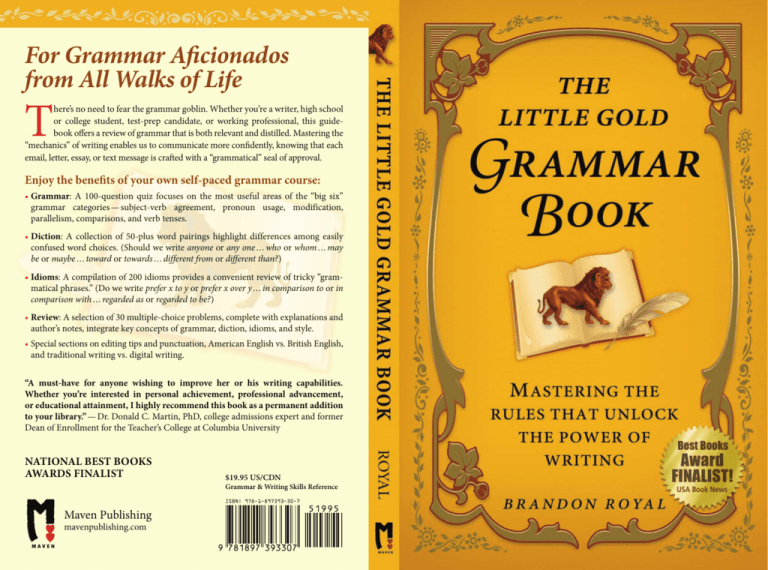
For Grammar Aficionados
from All Walks of Life
T
here’s no need to fear the grammar goblin. Whether you’re a writer, high school
or college student, test-prep candidate, or working professional, this guidebook offers a review of grammar that is both relevant and distilled. Mastering the
“mechanics” of writing enables us to communicate more confidently, knowing that each
email, letter, essay, or text message is crafted with a “grammatical” seal of approval.
Enjoy the benefits of your own self-paced grammar course:
• Grammar: A 100-question quiz focuses on the most useful areas of the “big six”
grammar categories — subject-verb agreement, pronoun usage, modification,
parallelism, comparisons, and verb tenses.
• Diction: A collection of 50-plus word pairings highlight differences among easily
confused word choices. (Should we write anyone or any one … who or whom … may
be or maybe … toward or towards … different from or different than? )
• Idioms: A compilation of 200 idioms provides a convenient review of tricky “grammatical phrases.” (Do we write prefer x to y or prefer x over y … in comparison to or in
comparison with … regarded as or regarded to be? )
• Review: A selection of 30 multiple-choice problems, complete with explanations and
author’s notes, integrate key concepts of grammar, diction, idioms, and style.
• Special sections on editing tips and punctuation, American English vs. British English,
and traditional writing vs. digital writing.
“A must-have for anyone wishing to improve her or his writing capabilities.
Whether you’re interested in personal achievement, professional advancement,
or educational attainment, I highly recommend this book as a permanent addition
to your library.” — Dr. Donald C. Martin, PhD, college admissions expert and former
Dean of Enrollment for the Teacher’s College at Columbia University
NATIONAL BEST BOOKS
AWARDS FINALIST
$19.95 US/CDN
Grammar & Writing Skills Reference
Maven Publishing
mavenpublishing.com
THE
LITTLE GOLD
Grammar
B ook
MASTERING THE RULES
THAT UNLOCK THE POWER
OF WRITING
Brandon Royal
Published by Maven Publishing
© 2010 by Brandon Royal
All rights reserved. No part of this work may be reproduced or transmitted
in any form or by any means, electronic or mechanical — including
photocopying, recording, or any information storage and retrieval
system — without permission in writing from the author or publisher.
Reviewers, however, may quote brief passages in a review, and
individuals wanting to reference material from this book for academic
or non-commercial purposes may do so provided the book, with title
and author’s name, is cited as a source.
Published by:
Maven Publishing
4520 Manilla Road, Calgary, Alberta, Canada T2G 4B7
www.mavenpublishing.com
Library and Archives Canada Cataloguing in Publication:
Royal, Brandon
The little gold grammar book : mastering the rules that unlock the
power of writing / by Brandon Royal.
ISBN 978-1-897393-30-7
Library of Congress Control Number: 2009909354
In addition to the paperback edition, this book is available in the Adobe
PDF file format and through the Mobipocket digital platform, including
Amazon Kindle.
Technical Credits:
Cover Design: George Foster, Fairfield, Iowa, USA
Editing: Jonathan K. Cohen, Irvine, California, USA
This book’s cover text was set in Minion. The interior text was set in
Scala and Scala Sans.
Contents
Introduction
Chapter 1:
Chapter 2:
Chapter 3:
Chapter 4:
5
The 100-Question Quiz
7
Subject-Verb Agreement
Pronoun Usage
Modification
Parallelism
Comparisons
Verb Tenses
Diction Review
Idioms Review
Answers to The 100-Question Quiz
8
12
16
18
21
23
27
29
33
Grammatical Munchkins
53
The Eight Parts of Speech
Parts of Speech vs. The Seven Characteristics
Other Grammatical Terms
54
56
58
Word Gremlins
71
Diction Showdown
200 Common Grammatical Idioms
72
92
Putting It All Together
99
30 All-Star Grammar Problems
Answers and Explanations
100
119
Editing I – Tune-up
147
Editing II – Punctuation Highlights
173
American English vs. British English
193
Traditional Writing vs. Digital Writing
201
Selected Bibliography
207
Index
209
About the Author
Editing II – Punctuation
Highlights
In spoken English, we can convey our meaning through voice
and body language: waving hands, rolling eyes, raising eyebrows,
stress, rhythm, intonations, pauses, and even repeated sentences.
In written language, we do not have such an arsenal of props; this
is the unenviable job of punctuation. Mastery of punctuation,
along with spelling, requires further review, and is not the focus
of this book. But two key areas — commas and semicolons — are
addressed because they represent areas where some of the most
common punctuation errors occur.
173
THE LITTLE GOLD GRAMMAR BOOK
Commas
It is said that ninety percent of writers can use the comma
correctly seventy-five percent of the time, but only one percent
of writers can use the comma correctly ninety-nine percent of
the time. The comma is often used, but often used incorrectly.
The well-known advice that a comma be used whenever there is
a pause is terribly misleading. Arguably the best way to master
the comma is to think of every comma as fitting into one of six
categories: listing comma, joining comma, bracketing comma,
contrasting comma, omission comma, or confusion comma.
Listing Comma
A listing comma separates items in a series. If more than
two items are listed in a series, they should be separated by
commas. The final comma in the series, the one that precedes
the word and, is required (see Appendix II – American English vs.
British English for further discussion about the use of a comma
before a final “and”).
Correct
A tostada is usually topped with a variety of
ingredients, such as shredded meat or chicken,
refried beans, lettuce, tomatoes, and cheese.
Do not place commas before the first element of a series or after
the last element.
Incorrect
The classic investment portfolio consists, of
stocks, bonds, and short-term deposits.
Remove the comma placed after the word
“consists.”
Correct
The classic investment portfolio consists of
stocks, bonds, and short-term deposits.
174
EDITING II – PUNCTUATION HIGHLIGHTS
Incorrect
Conversation, champagne, and door prizes, were
the highlights of our office party.
Remove the comma placed after the word
“prizes.”
Correct
Conversation, champagne, and door prizes were
the highlights of our office party.
Bracketing Comma
There are four main uses of the bracketing comma: (1) to set off
nonessential information in the middle of a sentence; (2) to set
off an opening phrase or clause; (3) to set off a closing phrase or
clause; and (4) to set off speech in direct dialogue.
First, bracketing commas set off nonessential (nonrestrictive)
information placed in the middle of a sentence. Such
information (in the form of phrases and clauses) is not essential
to the main idea of the sentence; in fact, we can test this. If after
omitting words the sentence still makes sense, we know these
words are nonessential and optional.
Correct
The Tale of Genji, written in the eleventh century,
is considered by literary historians to be the
world’s first novel.
The main idea is that The Tale of Genji is considered to be the
world’s first novel. The intervening phrase, “written in the
eleventh century,” merely introduces additional but nonessential
information.
Correct
The old brick house that is painted yellow is now
a historical landmark.
Correct
The old brick house at O’Claire Point, which we
visited last year, is now a historical landmark.
175
THE LITTLE GOLD GRAMMAR BOOK
In the first of the two examples above, “that is painted yellow”
defines which old brick house the author is discussing. In the
second example, the main point is that the old brick house at
O’Claire Point is now a historical landmark, and the intervening
clause “which we visited last year” merely adds additional but
nonessential information.
The second major use of the bracketing comma is to set
off opening phrases and clauses from the main sentence
(independent clause).
Correct
Like those of Sir Isaac Newton, the scientific
contributions of Albert Einstein have proven
monumental.
A comma in the above sentence separates the
prepositional phrase “like those of Sir Issac
Newton” from the main sentence.
Correct
Having collected rare coins for more than fifteen
years, Bill was heartbroken when his collection
was stolen in a house burglary.
A comma separates the participial phrase
“having collected rare coins for more than
fifteen years” from the main sentence. This
participle (or participial) phrase serves as an
adjective in describing Bill.
If the opening phrase is very short, the use of the comma is
considered optional. In the following example, the decision
whether to use a comma after “at present” rests with the writer.
Correct
At present we are a crew of eight.
The third major use, though not as common as the first two
uses, involves bracketing a nonessential closing phrase or clause
from the main sentence (independent clause).
176
EDITING II – PUNCTUATION HIGHLIGHTS
Correct
I hope we can talk more about this idea during
the conference, if time permits.
A comma is used to set off the phrase “if time
permits” because this phrase functions as a
piece of nonessential information. If we deleted
these words, the sentence would still make
sense.
Correct
They woke up at 6 a.m., when they heard the
rooster crowing.
Correct
They woke up when they heard the rooster
crowing.
The first of the above two sentences contains
a nonessential clause which is bracketed. The
fact that “they woke up at 6 a.m.” is the critical
information. The reason for their waking up is
auxiliary information. However, in the second
sentence, “when they heard the rooster crowing”
is critical information about why they woke up.
This restrictive information is not set off by
commas.
Note: A point of possible confusion occurs when a sentence
ends with a phrase or clause beginning with “which.” For
example, “I like that new brand of coffee, which is now on
sale.” It is common practice to place a comma before “which”
because it is assumed that such closing phrases or clauses are
parenthetical. That is, they do not contain defining or essential
information and should therefore be preceded by a comma. It
is also common practice not to place a comma before phrases
or clauses beginning with the word “that” because it is assumed
that such phrases or clauses do contain defining or essential
information. However, the question remains, Is a comma
really necessary, especially in this short sentence? One editing
trick is to substitute “that” for “which” in order to edit out the
177
THE LITTLE GOLD GRAMMAR BOOK
comma (along with the word “which”). Nonetheless, for those
who prefer to use “which” without the comma (at least in short
sentences as in the example above), one rationale for doing so is
the fact that these two words — “that” and “which” — are virtually
interchangeable in meaning.
The fourth major use of the bracketing comma is to set off
quoted speech from the speaker.
Correct
The waitress said, “Welcome.”
“Thank you,” we replied.
The same treatment is afforded to unspoken dialogue or
“thought speech.” Most commonly it is enclosed within
quotation marks, but alternatively, it may be italicized to
contrast it with actual speech.
Correct
“And what is the use of a book,” thought Alice,
“without pictures or conversation?”
Correct
And what is the use of a book without pictures or
conversation?
Note that is not necessary to use both a speech tag (e.g.,
“thought Alice”) and italics, since use of both techniques is
redundant. Placing “thought speech” in quotation marks is
common practice in nonfiction writing. Placing “thought
speech” in italics is common practice in fiction writing.
Similar treatment is applied when setting off a quotation.
Correct
Was it Robert Frost who wrote, “Good fences
make good neighbors”?
One important distinction arises between the direct quotations
and material that is merely surrounded by quotation marks. In
the latter situation, we punctuate, with reference to commas, in
exactly the same manner as we would “regular” sentences. This
178
EDITING II – PUNCTUATION HIGHLIGHTS
is also the same method used for punctuating sentences when
dealing with sayings, maxims, adages, aphorisms, proverbs, or
mottoes.
Correct
The statement “Some cats are mammals”
necessarily implies that “Some mammals are
cats.”
(It’s the writer choice whether to capitalize the
word “some.”)
Correct
Our manager’s favorite saying, “Rein in the
nickels,” is also his most annoying.
In the example above, commas are used because the saying
“Rein in the nickels” is effectively nonessential information,
the omission of which would still not destroy the sentence.
Case in point: “Our manager’s favorite saying is also his most
annoying.”
Note: Bracketing commas are, of course, used with dates,
addresses, and salutations (opening lines of letters or memos)
and complimentary closes. These uses are quite common and
easily understood; they are not covered here as they are unlikely
to cause confusion.
Joining Comma
Use commas to separate independent clauses connected by
coordinating conjunctions such as and, but, yet, or, nor, for, and
so. (Independent clauses are clauses that can stand alone as
complete sentences.)
Correct
Susan wants to get her story published, and she
wants to have it made into a movie.
Correct
Maurice ate habanero peppers with almost every
meal, yet he hardly ever got indigestion.
179
THE LITTLE GOLD GRAMMAR BOOK
The following is a potentially tricky situation in which it is
difficult to determine whether the comma goes before or after
the and.
Correct
I’ll put together a business plan, and by next
week, I’ll send it to a few potential investors.
In the previous example, there must be a joining comma before
and, and ideally a bracketing comma after week. We have, after
all, two complete sentences: “I’ll put together a business plan”
and “By next week, I’ll sent it to a few potential investors.” Note
that the comma before and cannot be a bracketing comma
because we cannot remove the words “and by next week”
without creating a run-on sentence (i.e., two sentences that are
joined without proper punctuation). Note that we could put
a comma after and (given that “by next week” is an optional
phrase), but we typically do not as a matter of practice. Thus, in
the next example below, the use of a third comma, although not
visually pleasing, is not incorrect:
Correct
I’ll put together a business plan, and, by next
week, I’ll send it to a few potential investors.
Correct
Some experts do not believe alcoholism should
be called a disease and, moreover, believe
that any type of dependency can be cured by
identifying and treating its underlying causes.
In the previous example, we do not have two complete
sentences, so we cannot have a joining comma (i.e., “believe
that any type of dependency can be cured by identifying and
treating its underlying causes” is not a complete sentence).
But since the connecting word “moreover” is merely optional,
it should be enclosed with commas. In other words, we could
write: “Some experts do not believe alcoholism should be called
a disease and believe that any type of dependency can be cured
by identifying and treating its underlying causes.” Knowing
180
EDITING II – PUNCTUATION HIGHLIGHTS
that we can omit a word or words and still have a sentence that
makes sense is the telltale sign that we have an optional phrase.
Note: A joining comma is optional in the case of two very
short, complete sentences (independent clauses) joined by a
coordinating conjunction.
Correct
The rain has stopped and the sun is shining.
Correct
The clouds are gone but it’s windy.
The coordinating conjunctions “and” and “but” each join two
complete sentences.
Contrasting Comma
Correct
The new music director vowed to take an active,
not passive, fundraising role.
Correct
She didn’t cry from sorrow and pain, but from
relief and joy.
In both of the above sentences, there is sufficiently strong
contrast to warrant the use of a contrasting comma.
Correct
A poorer but happier man could not be found.
In the above example, however, no commas are used to bracket
the words “but happier.” The important point in deciding
whether to use contrasting commas rests primarily with the
emphasis needed within a given sentence. Strong emphasis
will require commas to separate contrasting word groups; light
to moderate emphasis will not require the aid of commas.
Note that the distinction regarding using or not using a pair of
contrasting commas has little to nothing to do with whether the
words are essential. It could be argued that all information is
essential when using contrasting commas.
181
THE LITTLE GOLD GRAMMAR BOOK
Note: When “because” joins two parts of a sentence, does
a comma go before the word “because”? This is a mystery
question open to debate. Consider these two examples:
Correct
Don’t forget to bring an umbrella because it’s
going to rain out.
Correct
To tell those grief-stricken people that we know
how they are feeling is disingenuous, because
we don’t know.
Some people like to place a comma before almost every use of
“because.” They would prefer to write, “Don’t forget to bring an
umbrella, because it’s going to rain out.” A likely better, more
consistent practice is to use a comma before “because” only if
it qualifies as a contrasting comma, or perhaps a bracketing
comma.
Case in point: There is not a strong sense of contrast between
the need to remember to bring an umbrella given the likelihood
of rain. There is, however, a stronger sense of contrast in
thinking we know how other grief-stricken people feel and
the fact that we don’t know how they feel. Most often, we will
not require a comma before the word “because.” First, use
of the subordinating conjunction “because” creates a logical
connection between ideas in a sentence, making it unlikely
that the information it connects is nonessential (therefore no
bracketing comma is needed). Second, the word “because”
embodies a reasonable degree of contrast, obviating the need for
a contrasting comma.
Use a comma to separate word groups that flow in natural
opposition to each other.
Correct
Out of sight, out of mind.
Correct
The more you practice, the better you’ll get.
182
EDITING II – PUNCTUATION HIGHLIGHTS
A contrasting comma is also used to separate two identical
words in succession.
Correct
This is a great, great ice-cream flavor.
Correct
Many, many articles have been written about
weight loss and weight gain.
Omission Comma
Use commas to indicate missing words. In those situations
involving adjectives, the missing word is typically and.
Correct
I can’t believe you sat through that long, dull,
uninspired lecture without once checking your
watch.
We can test this sentence by replacing each comma with and:
Correct
I can’t believe you sat through that long and dull
and uninspired lecture without once checking
your watch.
Correct
It was a juicy, ripe mango.
Incorrect
It was a juicy ripe mango.
Incorrect
It was a juicy, ripe, mango.
A comma is required to separate juicy from ripe. There are two
ways to confirm this. First, substitute and for the comma and
see if things still make sense. (Example: “It was a juicy and ripe
mango.”) Second, reverse the word order and see if the sentence
makes sense. (Example: “It was a ripe, juicy mango.”) Either or
both of these tests confirm that a comma is needed.
A comma should not be placed after ripe because and cannot
be substituted for it. For instance, the phrase “ripe and mango”
183
THE LITTLE GOLD GRAMMAR BOOK
makes no sense. The rule is that a comma should not be placed
between the modifier and the noun it modifies.
A comma can be used to take the place of omitted words.
Correct
The first playoff game was exciting; the second,
dull.
In the above sentence, the comma takes the place of the “playoff
game was.” The sentence effectively reads: “The first playoff
game was exciting; the second playoff game was dull.”
Confusion Comma
A comma may be used to prevent confusion, particularly in
those situations where the absence of a comma would otherwise
cause the reader to misread.
Incorrect
To Karen Jane was as heroic a real-life character
as could be found in any novel.
Correct
To Karen, Jane was as heroic a real-life character
as could be found in any novel.
The eye cannot resist reading both names together as if they
represent a first and last name.
Incorrect
Run for your life is in danger.
Correct
Run, for your life is in danger.
One could argue that a contrasting comma is needed in the
above example. However, the actual problem is that the reader’s
eye has trouble knowing how to group the words properly.
Incorrect
The speaker said: “On Day 1 I will discuss the
reasons for the global increase in diabetes and
184
EDITING II – PUNCTUATION HIGHLIGHTS
on Day 2 I will talk about how to curtail this
trend.”
Correct
The speaker said: “On Day 1, I will discuss the
reasons for the global increase in diabetes, and
on Day 2, I will talk about how to curtail this
trend.”
Obviously, a comma is needed in the above example to avoid
confusion between the close proximity of the numbers 1 and 2
and the personal pronoun “I.”
The difference between the right
word and almost the right word is
the difference between lightning
and a lightning bug.
— Mark T wain
185
THE LITTLE GOLD GRAMMAR BOOK
Exercises
Correct the comma usage in each sentence by observing its five
uses: listing, bracketing, joining, contrasting, or omission.
1.
The Oscar the Emmy and the Tony are three related
awards which confuse many people.
2.
Emerging from the ruins of the World War II Japan
embarked on an economic recovery that can be only
viewed in historical terms as astonishing.
3.
Every major band requires, a lead singer, a lead guitarist, a
bass guitarist, and a drummer.
4.
A dedicated empathetic individual can achieve lifetime
recognition as a United Nations worker.
5.
More than a few people were shocked to discover that a
torn, previously worn, pair of Madonna’s underwear sold
for more money at auction than did a large, splendid,
sketch by Vignon.
6.
The more he talked with her the more he liked her.
7.
The crowded housing tenement, a cluster of rundown,
look-alike apartments was the site of the Prime Minister’s
birthplace.
8.
South Africa is famous for her gold and diamonds,
Thailand, for her silk and emeralds, and Brazil for her
coffee and sugarcane.
9·
She reached for the clock, and finding it, hastily silenced
the alarm.
10. Josie originally wanted to be a nurse but after finishing
university she decided to become a flight attendant instead.
186
EDITING II – PUNCTUATION HIGHLIGHTS
Semicolons
Use a semicolon instead of a coordinating conjunction (i.e., and,
but, yet, or, nor, for, so) to link two closely related sentences. The
key thing to remember is that a semicolon separates complete
sentences. It is not used if one or more of those sentences is a
fragment.
Correct
Today’s students are more creative and
technologically savvy, but they are also weaker in
the basics of reading, writing, and arithmetic.
Correct
Today’s students are more creative and
technologically savvy; they are also weaker in the
basics of reading, writing, and arithmetic.
Use a semicolon between independent clauses connected by
words such as however, therefore, moreover, nevertheless, and
consequently. These special words are called conjunctive adverbs.
Incorrect
The formulas for many scientific discoveries
appear rudimentary, however, when one
examines a derivation behind these formulas
they do not seem so rudimentary after all.
Correct
The formulas for many scientific discoveries
appear rudimentary; however, when one
examines a derivation behind these formulas
they do not seem so rudimentary after all.
Run-on Sentence
To see commas and semicolons in action, let’s review a very
common error — the run-on sentence. A run-on refers to two
sentences that are inappropriately joined together, usually by
a comma. There are effectively four ways to correct a run-on
sentence, as seen in each of the four correct options below. First,
join the two sentences with a semicolon. Second, join the two
187
THE LITTLE GOLD GRAMMAR BOOK
sentences with a coordinating conjunction (e.g., and, but, yet,
or, nor, for, so). Third, separate the two sentences with a period.
Fourth, turn one of the two sentences into a subordinate clause.
Incorrect
Technology has made our lives easier, it has also
made our lives more complicated.
Correct
Technology has made our lives easier; it has also
made our lives more complicated.
This solution involves changing the comma to a
semicolon.
Correct
Technology has made our lives easier, and it has
also made our lives more complicated.
This solution involves joining two sentences
with a coordinating conjunction.
Correct
Technology has made our lives easier. It has also
made our lives more complicated.
This solution involves making two separate
sentences.
Correct
Even though technology has made our
lives easier, it has also made our lives more
complicated.
This solution involves turning one sentence
into a subordinate clause. Here the focus is
on the idea that technology has made our lives
more complicated (independent clause). The
subordinate idea is that it has made our lives
easier (subordinate clause). It would also be
equally correct to say: “Even though technology
has made our lives more complicated, it has also
188
EDITING II – PUNCTUATION HIGHLIGHTS
made our lives easier.” Now the central idea and
subordinate idea are reversed.
Answers to Exercises
1.
The Oscar, the Emmy, and the Tony are three related
awards which confuse many people.
The comma after Emmy is required in American English
but omitted in British English.
2.
Emerging from the ruins of the World War II, Japan
embarked on an economic recovery that can only be
viewed in historical terms as astonishing.
A bracketing comma is required after “World War II.”
3.
Every major band requires a lead singer, a lead guitarist, a
bass guitarist, and a drummer.
There should be no comma after the verb “requires.”
4.
A dedicated, empathetic individual can achieve lifetime
recognition as a United Nations worker.
An omission comma separates “dedicated and
empathetic.” There are two ways to test for this. First,
substitute the word “and” to read “dedicated and
empathetic.” Second, reverse the order of the two words
to read “empathetic, dedicated individual.” Since either
substituting the word “and” or reversing the word order
still makes sense in context, a comma should be used.
5.
More than a few people were shocked to discover that a
torn, previously worn pair of Madonna’s underwear sold
for more money at the auction than did a large, splendid
sketch by Vignon.
189
THE LITTLE GOLD GRAMMAR BOOK
There are no commas after “previously worn” or “sketch.”
A comma is not placed between a modifier and the word
it modifies. Here the words being modified are a “pair of
Madonna’s underwear” and “sketch.”
6.
The more he talked with her, the more he liked her.
A contrasting comma after “her” is required.
7.
That crowded housing tenement, a cluster of run-down,
look-alike apartments, was the site of the Prime Minister’s
birthplace.
Insert a comma after “apartments”; the phrase “a cluster
of run-down, look-alike apartments” is nonessential (and
therefore optional) and should be enclosed with commas.
8.
South Africa is famous for her gold and diamonds,
Thailand, for her silk and emeralds, and Brazil, for her
coffee and sugarcane.
A comma is needed after Thailand and Brazil. Such a
comma (an omission comma) takes the place of the words
“is famous.” So, the sentence effectively reads: “South
Africa is famous for her gold and diamonds, Thailand is
famous for her silk and emeralds, and Brazil is famous for
her coffee and sugarcane.”
There are at least two additional ways to correct this
sentence:
i) By omitting the second comma in the original:
“South Africa is famous for her gold and diamonds,
Thailand for her silk and emeralds, and Brazil for her
coffee and sugarcane.”
The treatment is consistent with the rules of ellipsis. We
can acceptably omit words (in this case the words “is
famous”) when they are readily understood in context.
190
EDITING II – PUNCTUATION HIGHLIGHTS
ii) By using semicolons with commas:
“South Africa is famous for her gold and diamonds;
Thailand, for her silk and emeralds; and Brazil, for her
coffee and sugarcane.”
Semicolons can be used in conjunction with commas,
especially in cases of heavily punctuated sentences. The
final “and” appearing before “Brazil” is optional.
9.
She reached for the clock and, finding it, hastily silenced
the alarm.
A bracketing comma is needed before and after the words
“finding it”; this is a nonessential phrase. Removing these
words still results in a complete sentence. Case in point:
“She reached for the clock and hastily silenced the alarm.”
If, however, we were to remove the words “and finding it,”
the sentence would become nonsensical: “She reached
for the clock hastily silenced the alarm.” Therefore this
confirms that a set of bracketing commas cannot be used
in the original sentence.
10. Josie originally wanted to be a nurse, but after finishing
university, she decided to become a flight attendant
instead.
A joining comma is required before “but,” while a
bracketing comma is required after “university.” We
effectively have two sentences: “Josie originally wanted to
be a nurse” and “After finishing university, she decided
to become a flight attendant.” In the solution above, the
two commas do not both function as bracketing commas;
if this were so we could cut out the phrase “but after
finishing university” and the sentence would still make
sense, but it doesn’t: “Josie originally wanted to be a nurse
she decided to become a flight attendant instead.”
191
Books by Brandon Royal:
The Little Red Writing Book:
20 Powerful Principles of Structure, Style and Readability
Writer’s Digest
ISBN: 978-1-1582975-21-4
The Little Gold Grammar Book:
Mastering the Rules That Unlock the Power of Writing
Maven Publishing
ISBN: 978-1-897393-30-7
The Little Green Math Book:
30 Powerful Principles for Building Math and Numeracy Skills
Maven Publishing
ISBN: 978-1-897393-50-5
The Little Blue Reasoning Book:
50 Powerful Principles for Clear and Effective Thinking
Maven Publishing
ISBN: 978-1-897393-60-4
Chili Hot GMAT:
200 All-Star Problems to Get You a High Score on Your GMAT Exam
Maven Publishing
ISBN: 978-1-897393-70-3
Secrets to Getting into Business School:
100 Proven Admissions Strategies to Get You Accepted at the MBA
Program of Your Dreams
Maven Publishing
ISBN: 978-1-897393-80-2
Bars of Steel:
Life before Love in a Hong Kong Go-Go Bar – The True Story of Maria de
la Torre
Maven Publishing
ISBN: 978-1-897393-00-0
Pleasure Island:
You’ve Found Paradise, Now What? (A Modern Fable on How to Keep
Your Dreams Alive)
Maven Publishing
ISBN: 978-1-897393-10-9
For Grammar Aficionados
from All Walks of Life
T
here’s no need to fear the grammar goblin. Whether you’re a writer, high school
or college student, test-prep candidate, or working professional, this guidebook offers a review of grammar that is both relevant and distilled. Mastering the
“mechanics” of writing enables us to communicate more confidently, knowing that each
email, letter, essay, or text message is crafted with a “grammatical” seal of approval.
Enjoy the benefits of your own self-paced grammar course:
• Grammar: A 100-question quiz focuses on the most useful areas of the “big six”
grammar categories — subject-verb agreement, pronoun usage, modification,
parallelism, comparisons, and verb tenses.
• Diction: A collection of 50-plus word pairings highlight differences among easily
confused word choices. (Should we write anyone or any one … who or whom … may
be or maybe … toward or towards … different from or different than? )
• Idioms: A compilation of 200 idioms provides a convenient review of tricky “grammatical phrases.” (Do we write prefer x to y or prefer x over y … in comparison to or in
comparison with … regarded as or regarded to be? )
• Review: A selection of 30 multiple-choice problems, complete with explanations and
author’s notes, integrate key concepts of grammar, diction, idioms, and style.
• Special sections on editing tips and punctuation, American English vs. British English,
and traditional writing vs. digital writing.
“A must-have for anyone wishing to improve her or his writing capabilities.
Whether you’re interested in personal achievement, professional advancement,
or educational attainment, I highly recommend this book as a permanent addition
to your library.” — Dr. Donald C. Martin, PhD, college admissions expert and former
Dean of Enrollment for the Teacher’s College at Columbia University
NATIONAL BEST BOOKS
AWARDS FINALIST
$19.95 US/CDN
Grammar & Writing Skills Reference
Maven Publishing
mavenpublishing.com


